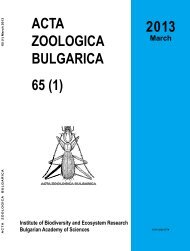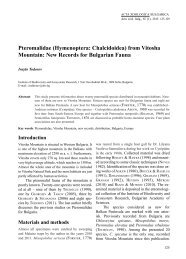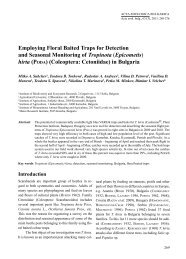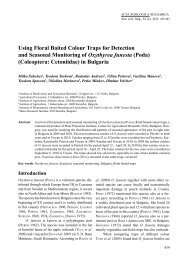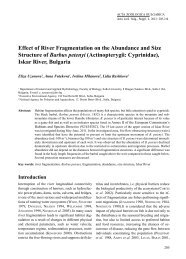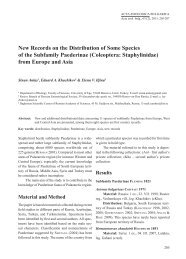in Fish Farms in Bulgaria - Acta zoologica bulgarica
in Fish Farms in Bulgaria - Acta zoologica bulgarica
in Fish Farms in Bulgaria - Acta zoologica bulgarica
You also want an ePaper? Increase the reach of your titles
YUMPU automatically turns print PDFs into web optimized ePapers that Google loves.
ACTA ZOOLOGICA BULGARICA<br />
<strong>Acta</strong> zool. bulg., 63 (2), 2011: 187-193<br />
Parasites of Topmouth Gudgeon Psudorasbora parva<br />
(Schlegel) <strong>in</strong> <strong>Fish</strong> <strong>Farms</strong> <strong>in</strong> <strong>Bulgaria</strong><br />
Nichola M. Margaritov 1 , Savas G. Kiritsis *<br />
Faculty of Biology,University of Sofia, 8 Dragan Tzankov Blvd. , Sofia 1164, <strong>Bulgaria</strong>; E-mail: nmargaritov@mail.bg<br />
Abstract: There are 26 parasite species on the topmouth gudgeon (stone moroko) <strong>in</strong> <strong>Bulgaria</strong> (20 Protozoa, 3<br />
Monogenea, 1 Nematoda, 2 Crustacea). Nonspecific widely spread parasites prevail, of which the most<br />
common are trichod<strong>in</strong>ids (11 species). In the parasite fauna, after its acclimatisation <strong>in</strong> <strong>Bulgaria</strong>, was<br />
established only one species – Gyrodactylus gobion<strong>in</strong>um (Monogenea), transferred with the host from its<br />
natural area. Asian parasite Lerrnaea elegans was established on it as well, <strong>in</strong>troduced with herbivorous<br />
fish to <strong>Bulgaria</strong>. Ma<strong>in</strong> parasites <strong>in</strong> descend<strong>in</strong>g ordnung of topmouth gudgeon as trash fish <strong>in</strong> fish farms<br />
are: Trichod<strong>in</strong>a rectangli rectangli, T. acuta, Gyrodactylus gobion<strong>in</strong>um, Trichod<strong>in</strong>a reticulata, Pseudocapillaria<br />
tomentosa. Morphometric data of G. gobion<strong>in</strong>um are supplemented. There has been found an<br />
exchange of parasites among stone moroko, artificially cultivated fish and trash fish. The updated global<br />
list of parasites of topmouth gudgeon consists of 84 species, of which: Protozoa 40, Monogenea 10, Cestoda<br />
3, Trematoda 16, Nematoda 3, Acanhocephala 6, Bivalvia 1, Crustacea 4, Hirud<strong>in</strong>ea 1.<br />
Key words: Pseudorasbora parva, Gyrodactylus gobion<strong>in</strong>um, Lernaea elegans, exchange of parasites, trash fish<br />
Introduction<br />
Stone moroko’s natural area is East Asia (Ch<strong>in</strong>a,<br />
Korea, Japan). Dur<strong>in</strong>g the acclimatization of herbivorous<br />
fish from Far East countries it has been transported<br />
un<strong>in</strong>tentionally to many new locations. It is<br />
established on all 6 cont<strong>in</strong>ents except for Antarctida.<br />
Orig<strong>in</strong>ally it was accidentally transferred to Romania<br />
directly from Ch<strong>in</strong>a with fish fry <strong>in</strong> 1962 to Nucet<br />
fish farm, Dambovita County, then made its way <strong>in</strong>to<br />
Danube, thus spread<strong>in</strong>g throughout Europe.<br />
It probably entered <strong>Bulgaria</strong> via Danube<br />
through the herbivorous fish stock from former<br />
USSR. It was first found <strong>in</strong> the country <strong>in</strong> Mechka<br />
fish farm, near Russe, <strong>in</strong> 1975 (MARINOV 1979), 1976<br />
(MANOLOV, SIVKOV 1977). It later spread almost all<br />
over the country (JANCOVIC, KARAPETKOVA 1992,<br />
KARAPETKOVA, ŽIVKOV 1995). Now it is one of the<br />
most common trash fish species <strong>in</strong> fish farms.<br />
This article aims to clarify the regularities of climate<br />
parasite fauna of stone moroko after acclimatization<br />
and its role and importance as trash fish.<br />
Materials and Methods<br />
Studies were <strong>in</strong>itially carried out <strong>in</strong> two farms<br />
(Chelopechene, near Sofia and Bezden). Seasonal<br />
dynamics of <strong>in</strong>fection were traced <strong>in</strong> a model fish<br />
farm (Chelopechene) <strong>in</strong> 1987 and 1988, when 125<br />
live fish specimens were exam<strong>in</strong>ed. Dimensions are<br />
with<strong>in</strong> L = 57 – 102 (Mx = 84) mm. In addition 117<br />
more fish specimens, fixed <strong>in</strong> 4% formaldehyde solution,<br />
were later tested for sk<strong>in</strong>, gill helm<strong>in</strong>ths and<br />
parasitic crustaceans <strong>in</strong> four fishfarms (Mechka,<br />
*<br />
This article is a doctoral thesis material of PhD student S. Kiritsis, published posthumously <strong>in</strong> his memory.<br />
187
Margaritov N., S. Kiritsis<br />
Krusha, Plovdiv and Pisanets), collected respectively<br />
<strong>in</strong> 1975, 1991 and 1997. Dimensions are L = 42 – 94<br />
(Mx = 75) mm. Research <strong>in</strong> the model fishfarm was<br />
carried out by Dogiel’s method of complete parasitological<br />
analysis (BYKHOVSKAYA-PAVLOVSKAYA, 1952,<br />
MUSSELIUS 1983). The <strong>in</strong>tensity of <strong>in</strong>fection with<br />
unicellular parasites is def<strong>in</strong>ed <strong>in</strong> relative numbers<br />
(on average per one visible field of the microscope,<br />
at a magnification of 63 times, read<strong>in</strong>g 20-80 of<br />
them, depend<strong>in</strong>g on <strong>in</strong>tensity). Morphometric studies<br />
of the trichd<strong>in</strong>ids were made by Lom’s scheme<br />
(ERGENS, LOM 1970) and of the Monogenea – by that<br />
of GUSEV (1962, 1983, 1985). Results of fish <strong>in</strong>fection<br />
are processed statistically by ANOVA, qualitative<br />
for extensiveness and quantitative for <strong>in</strong>tensity<br />
of <strong>in</strong>fection. (PLOKHINSKY 1970).<br />
Results and Discussion<br />
Parasite fauna of the topmouth gudgeon, as trash<br />
fish <strong>in</strong> <strong>Bulgaria</strong>n fishfarms, consists mostly of<br />
widespread parasites <strong>in</strong> artificially cultivated and<br />
trash fish (Table 2). Gyrodactylus gobion<strong>in</strong>um and<br />
Lernanea elegans are the only two species that make<br />
an exception. Both are elements of the Asian parasite<br />
fish fauna but came to Europe <strong>in</strong> different ways.<br />
The former was transferred with stone moroko and<br />
the latter – with herbivorous fish. As a widespecific<br />
parasite it <strong>in</strong>fected it later, too.<br />
Result analysis of the species composition of<br />
the parasite fauna of <strong>Bulgaria</strong>n topmouth gudgeon<br />
confirms Dogiel’s basic environmental rules for<br />
changes <strong>in</strong> the parasite fauna of the host on acclimatization<br />
(DOGEL 1962, PETRUSHEVSKIY 1958, BAUER<br />
1975), GVOZDEV, AGAPOVA 1977, namely : 1.Parasite<br />
fauna impoverishment: 2.Remov<strong>in</strong>g or reduc<strong>in</strong>g the<br />
number of specific species: 3.Transfer of species<br />
with direct development from the aborig<strong>in</strong>al fauna,<br />
especially monogeneids which are particularly resistant<br />
under acclimatization: 4. Build<strong>in</strong>g of the parasite<br />
fauna of the host at the new location from local<br />
widespread species.<br />
When compar<strong>in</strong>g the number of parasite species<br />
by systematic groups of stone moroko, after acclimatization<br />
<strong>in</strong> Bilgaria with those <strong>in</strong> literature for<br />
its natural habitat, the follow<strong>in</strong>g major conclusions<br />
may be drawn: 1. The number of species of protozoan<br />
parasites <strong>in</strong>creases. 2. Approximately half of<br />
the unicellular parasites of the topmouth gudgeon<br />
after the <strong>in</strong>troduction are trichod<strong>in</strong>ids. 3. The number<br />
of biohelm<strong>in</strong>ths <strong>in</strong> the parasite fauna of the host<br />
is greatly reduced.<br />
F<strong>in</strong>d<strong>in</strong>g Gyrodactylus gobion<strong>in</strong>um on stone<br />
moroko <strong>in</strong> <strong>Bulgaria</strong>, which is typical for Asian fish<br />
parasite fauna, is of particular <strong>in</strong>terest. Its specificity<br />
and hosts are still open to discussion. GUSSEV (1955)<br />
described it from the Amur and Mo rivers and Hank<br />
lake for 6 species, <strong>in</strong>clud<strong>in</strong>g stone moroko, that belong<br />
to 6 genuses (Hermibarbus, Pseudorasbora,<br />
Chilogobio, Sarcochichtys, Pseudogobio and<br />
Rostrogobio). Gusev found differences between<br />
specimens of the parasite com<strong>in</strong>g from different<br />
hosts. Due to <strong>in</strong>sufficient material (1-3 specimens<br />
from each host) and mostly because of the considerable<br />
similarity between them, he temporarily attributed<br />
them to one species, regard<strong>in</strong>g the specimens of<br />
Pseudogobio rivularis as typical for the whole species<br />
(GUSSEV 1955). Later on the same author (GUSSEV<br />
1962) takes a similar view of taxonomic situation,<br />
specificity and parasite host range. BYKHOWSKY<br />
(1957), MALMBERG (1970, by GLÄSER 1974) was will<strong>in</strong>g<br />
to accept Gyrodactylus gobion<strong>in</strong>um as a assembly<br />
species. ERGENS (1973) redescribes G. gobionium<br />
on the basis of scarce material (1 s<strong>in</strong>type). Their<br />
varietal orig<strong>in</strong> can only be established with a large<br />
quantity of research subjects, as well as <strong>in</strong> study<strong>in</strong>g<br />
the morphometric variability of G. gobionium.<br />
In this connection, the same author (ERGENS, 1985)<br />
only po<strong>in</strong>ts Abott<strong>in</strong>a rivularis as the sole host of G.<br />
gobionium. It should be noted that the publications<br />
concern<strong>in</strong>g the issue of G. gobionium hosts do not<br />
discuss f<strong>in</strong>d<strong>in</strong>g the species <strong>in</strong> Czechoslovakia <strong>in</strong> the<br />
follow<strong>in</strong>g fish species: Gobio gobio (ERGENS 1959a,<br />
1962a, ZITNAN 1964 f, 1965b, 1966a), Gobio albip<strong>in</strong>natus<br />
(ZITNAN 1964f, 1965b, 1966a), Gobio kessleri<br />
(ZITNAN 1966, <strong>in</strong> MORAVEC 2001) and <strong>in</strong> Barbus<br />
meridionalis <strong>in</strong> Albania (ERGENS 1960).<br />
In contemporary studies of multiple materials<br />
of common gudgeon <strong>in</strong> the Czech Republic has<br />
not been found G.gobion<strong>in</strong>um (BLAZEK et al., 2008).<br />
The most recent reports of f<strong>in</strong>d<strong>in</strong>g G. gobion<strong>in</strong>um<br />
of stone moroko come from Kazakhstan (GVOZDEV,<br />
KARABEKOVA 2001) and Ch<strong>in</strong>a (WU BAO-HUA et al.,<br />
1991, <strong>in</strong> GIBSON 2003).<br />
The question of the orig<strong>in</strong> of G. gobionium is<br />
also open to discussion. Some authors take it to be an<br />
188
Parasites of Topmouth Gudgeon Psudorasbora parva (Schlegel) <strong>in</strong> <strong>Fish</strong> <strong>Farms</strong>...<br />
Table 1. Measurement (mm) of chit<strong>in</strong>oid haptor parts of G. gobion<strong>in</strong>um.<br />
Morphological data n m<strong>in</strong> – max<br />
Overall length of anchors 41 0.052 – 0.060<br />
Length of basal part 41 0.038 – 0.045<br />
Length of <strong>in</strong>ner part 41 0.015 – 0.020<br />
Length of po<strong>in</strong>t 11 0.023 – 0.028<br />
Length of pr<strong>in</strong>cipal connect<strong>in</strong>g part 36 0.006 – 0.008<br />
With pr<strong>in</strong>cipal of connect<strong>in</strong>g part 29 0.023 – 0.028<br />
Length of membrane 7 0.013 – 0.018<br />
Length of auxiliary bar 18 0.002 – 0.003<br />
With of auxiliary bar 12 0.018 – 0.025<br />
Overall length of marg<strong>in</strong>al hooks 41 0.024 – 0.027<br />
Length of hooklets 41 0.005 – 0.006<br />
Table 2. Checklist of the parasites of the host with localization accord<strong>in</strong>g to seasons.<br />
Parasites Spr<strong>in</strong>g Summer Autum<br />
Cryptobia branchialis NIE IN CHEN,1955 g g<br />
Ichthyobodo necator (HENNEGUY,1883) s, g s, g s, g<br />
Chilodonella hexasticha (KIERNIK,1909) s g g<br />
Chilodonella piscicola (ZACHARIAS,1894)<br />
s, nc<br />
Amphileptus branchiarum WENRICH,1924<br />
g<br />
Ichthyophthirius multifi liis (FOUQUET,1876)<br />
s, g<br />
Tetrahymena pyriformis (EHRENBERG,1830)<br />
s, g<br />
Apiosoma sp. s s, g<br />
Epistylis sp. s,g s s, g, nc<br />
Trichod<strong>in</strong>a reticulata HIRSCHMANN et PARTSCH,1955 s, g s, g s, g<br />
Trichod<strong>in</strong>a nobilis CHEN,1963<br />
s<br />
Trichod<strong>in</strong>a acuta LOM,1961 s, g s s, g<br />
Trichod<strong>in</strong>a nigra LOM,1961 s s<br />
Trichod<strong>in</strong>a rectengli rectangli CHEN et HSIEN,1964 nc nc nc<br />
Trichod<strong>in</strong>a cobitis LOM,1960<br />
s<br />
Paratrichod<strong>in</strong>a <strong>in</strong>cisa (LOM,1959)<br />
g<br />
Tripartiella copiosa LOM,1959 g g<br />
Tripartiella lata LOM,1953 g g<br />
Tripartiella obtusa ERGENS et LOM 1970 g g<br />
Trichod<strong>in</strong>ella epizootica (RAABE,1950) g g g<br />
Gyrodactylus gobion<strong>in</strong>um GUSEV,1955 g, f, s, cn g, s, f f, s<br />
Gyrodactylus cypr<strong>in</strong>i DIAROVA, 1964<br />
g<br />
Gyrodactylus kathar<strong>in</strong>eri MALMBERG, 1964<br />
s, g<br />
Pseudocapillaria tomentosa (DUJARDIN, 1843) i i i<br />
Lernaea elegans LEIGH-SHARPE, 1925<br />
s, f<br />
Lernaea sp. larvae<br />
g<br />
Argulus japonicus THIELE, 1900<br />
s<br />
s-sk<strong>in</strong> g-gills f-f<strong>in</strong>s nc-nasal cavity i-<strong>in</strong>test<strong>in</strong>e<br />
189
Margaritov N., S. Kiritsis<br />
Table 3. Seasonal and total <strong>in</strong>fection with parasites of Pseudorasbora parva <strong>in</strong> fish farm Chelopechene.<br />
Parasites<br />
Spr<strong>in</strong>g Summer Autumn Total<br />
ext. <strong>in</strong>t. ext. <strong>in</strong>t. ext. <strong>in</strong>t. ext. <strong>in</strong>t.<br />
Cryptobia branchialis 3.6 0.05 2.7 0.60 2.3 0.30<br />
Ichthyobodo necator 14.3 0.10 19.0 0.08 13.5 0.06 15.1 0.30<br />
A.branchiarum 10.7 0.01 3.5 0.01<br />
Chilodonella hexasticha 10.7 0.06 4.8 0.06 2.7 0.05 5.8 0.20<br />
Chilodonella piscicola 10.7 0.20 3.5 0.01<br />
Chilodonella sp. 32.1 0.10 9.5 0.08 12.7 0.10<br />
Tetraymena pyriformis 14.3 0.02 4.7 0.02<br />
I.multifi liis 14.3 0.01 4.7 0.01<br />
Epistylis sp. 7.1 0.04 9.5 0.01 16.2 0.02 11.6 0.02<br />
Apiosoma sp. 28.6 0.03 5.4 0.06 11.6 0.04<br />
Trichod<strong>in</strong>a reticulata 7,1 0,03 57,1 0,02 13,5 0,02 22,0 0,02<br />
Trichod<strong>in</strong>a nigra 7,1 0,05 4,8 0,01 3,5 0,04<br />
Trichod<strong>in</strong>a acuta 78,6 0,30 23,8 0,03 48,6 0,05 52,3 0,20<br />
T.rectangli rectangli 7,1 0,20 28,6 0,20 62,2 0,10 56,9 0,20<br />
Trichod<strong>in</strong>a nobilis 4,8 0,01 1,2 0,01<br />
Trichod<strong>in</strong>a cobitis 3,6 0,20 4,8 0,01 2,3 0,09<br />
Paratrichod<strong>in</strong>a <strong>in</strong>cisa 7,1 0,03 2,3 0,03<br />
Tripartiella copiosa 7,1 0,10 4,8 0,05 3,5 0,09<br />
Tripartiella lata 5,4 0,01 5,4 0,01 3,6 0,01<br />
Tripartiella obtusa 3,6 0,10 28,6 0,95 8,6 0,80<br />
Trichod<strong>in</strong>ella epizootica 14,3 0,07 16,2 0,10 11,6 0,08<br />
Gyrodactylus cypr<strong>in</strong>i 2,1 1,00 0,8 1,0<br />
G. gobion<strong>in</strong>um 23,4 12,1 61,9 10,2 34,5 3,40 34,9 5,1<br />
G. kathar<strong>in</strong>eri 23,4 1,4 8,9 1,4<br />
P. tomentosa 10,6 2,6 33,3 1,6 23,6 4,6 20,3 3,4<br />
Lernaea elegans 3,6 1,5 1,6 1,5<br />
L. elegans larvae 2,1 1,0 1,8 1,0 1,6 1,0<br />
ext.-extensity (%) of <strong>in</strong>fection <strong>in</strong>t.-<strong>in</strong>tensity of <strong>in</strong>fection<br />
Asian species (GUSSEV, 1955, 1978: SHULMAN 1958),<br />
others – a holarctic one (ERGENS 1960. 1962, 1973,<br />
1985: ERGENS 1959a, 1962a, ZITNAN 19664f, 1965b,<br />
1966, 1966a, <strong>in</strong> MORAVEC 2001), whereas still others<br />
– of unknown orig<strong>in</strong> (STRELKOV, SHULMAN 1971).<br />
To our m<strong>in</strong>d the second op<strong>in</strong>ion is not very conv<strong>in</strong>c<strong>in</strong>g<br />
for the follow<strong>in</strong>g reasons: Over the past few decades<br />
the parasite has not been found <strong>in</strong> Europe <strong>in</strong><br />
other fish species but the topmouth gudgeon. Specific<br />
parasite fauna of gudgeons, <strong>in</strong>clud<strong>in</strong>g stone moroko,<br />
especially monogeneids <strong>in</strong> their natural areal <strong>in</strong> East<br />
Asia, have s<strong>in</strong>oIndian orig<strong>in</strong>. Provid<strong>in</strong>g G. gobionium<br />
cross<strong>in</strong>g from one host to another is possible, it would<br />
be more likely that it happens from Asia to Europe<br />
and not vice versa. This was the way other fish and<br />
their specific parasites have spread (e.g. goldfish, gibel<br />
carp and the species specific for it from the genus<br />
Dactylogyrus).<br />
190
Parasites of Topmouth Gudgeon Psudorasbora parva (Schlegel) <strong>in</strong> <strong>Fish</strong> <strong>Farms</strong>...<br />
Fig.1. (a-f) – Chit<strong>in</strong>oid haptor parts of G. gobion<strong>in</strong>um. All adhesive discs are pr<strong>in</strong>ted to the same scale; bar = 20 μm.<br />
When compar<strong>in</strong>g our own results for G. gobion<strong>in</strong>um<br />
with those published so far the follow<strong>in</strong>g<br />
major conclusions can be made:<br />
1. The majority of specimens identified by us<br />
from the genus Gyrodactylus on stone moroko <strong>in</strong><br />
fish farms <strong>in</strong> <strong>Bulgaria</strong> belong to G. gobion<strong>in</strong>um.<br />
G. kathar<strong>in</strong>eri and G. cypr<strong>in</strong>i occur much less frequently<br />
(Table 3).<br />
2. The limits of variation of the taxonomic characteristics<br />
for the species expand, particularly total length<br />
and length of the average of the anchors. (Table 1).<br />
3. Apart from the f<strong>in</strong>s and gills the helm<strong>in</strong>th also<br />
<strong>in</strong>fects the body sk<strong>in</strong> and nasal cavity. This complements<br />
the <strong>in</strong>formation on its localization. (Table 2).<br />
4. G. gobionium is one of the ma<strong>in</strong> parasites<br />
of the topmouth gudgeon as trash fish <strong>in</strong> fish ponds<br />
<strong>in</strong> <strong>Bulgaria</strong>. Accord<strong>in</strong>g to general <strong>in</strong>fection (prevalence)<br />
it ranks third among them. (Table 3).<br />
191
Margaritov N., S. Kiritsis<br />
5. G. gobionium can be referred to warm-lov<strong>in</strong>g<br />
parasites. Its highest prevalence is observed <strong>in</strong><br />
summer. (Table 3).<br />
The higher <strong>in</strong>fection of the stone moroko <strong>in</strong> fish<br />
farms, as compared to that under natural conditions<br />
and areal, is probably due to the simultaneous operation<br />
of two factors: its herd lifestyle and the artificial<br />
conditions <strong>in</strong> the fishfarms.<br />
The species morphologically closest to G. gobionium<br />
are: G. gobiensis, G.gobii and G. parvae. The<br />
latter was described only recently (YOU et al., 2008).<br />
Accord<strong>in</strong>g to the ma<strong>in</strong> key morphological characteristics<br />
(the hooks, particularly the hooklets and the anchors)<br />
they can be divided <strong>in</strong>to two groups: G.gobii<br />
and G. parvae on one side and G. gobionium and G.<br />
gobiensis – on the other. The parasite species from<br />
the first group have thick massive hooklets, whereas<br />
those of the second one are th<strong>in</strong>ner and more exquisite.<br />
Species differentiation can also be made accord<strong>in</strong>g<br />
to the metric values of the various parts of the<br />
anchors. These of G.gobii and G. gobiensis are larger<br />
than those of G. gobionium and G. parvae. Accord<strong>in</strong>g<br />
to our observations, upper abdom<strong>in</strong>al bar of hapter of<br />
G.gobion<strong>in</strong>um is concave <strong>in</strong> middle (Fig.1 a-f). This<br />
characteristic morphological feature that is seen on<br />
light microscope without fazekontrast equipment and<br />
with material fixed <strong>in</strong> formal<strong>in</strong>. It must be stressed<br />
that this sign is <strong>in</strong>dicated <strong>in</strong> the orig<strong>in</strong>al description<br />
of species by GUSSEV (1955). However, is not<br />
mentioned <strong>in</strong> the redescription by ERGENS (1973), although<br />
<strong>in</strong>clided <strong>in</strong> the picture (2a).<br />
F<strong>in</strong>d<strong>in</strong>g the Asian parasite Lernaea elegans on the<br />
stone moroko <strong>in</strong> <strong>Bulgaria</strong> is also of particular <strong>in</strong>terest.<br />
Regard<strong>in</strong>g natural habitat it has been designated for<br />
Korea (HONTA et al, 1939,.), Ch<strong>in</strong>a (YIN et al., 1962,<br />
<strong>in</strong> NAGASAVA 2007) and Iran (BARZEGER, JALALI 2009).<br />
These autors consider it synonymous L.cypr<strong>in</strong>acaea.<br />
The taxonomic position of both species is still open to<br />
discussion. Some expetrs regard them as synonyms,<br />
others as <strong>in</strong>dependent species. The second group of<br />
authors believe that L. cyr<strong>in</strong>acea is highly specific<br />
and so <strong>in</strong>fects cruzians, ma<strong>in</strong>ly Carasius carasius.<br />
Unlike it L. elegans is widely specific harboured by<br />
many artificially bred fresh-water fish: common carp,<br />
herbivorous fish, buffalo fish, etc. L. cyr<strong>in</strong>acea is a<br />
European parasite, whereas L. elegans is considered<br />
to be an Asian species. It was brought to Europe with<br />
herbivorous fish (PODUBNAYA 1973, MUSSELIUS 1973,<br />
BAUER et al, 1981). The epizootological observations<br />
<strong>in</strong> fish ponds support this view. In recent decades lerneoza<br />
epidemics affect primarily buffalo fish, where<br />
there is no balance <strong>in</strong> the host-parasite system.<br />
After be<strong>in</strong>g acclimatized <strong>in</strong> <strong>Bulgaria</strong> the topmouth<br />
gudgeon has received almost all its parasites<br />
from farm<strong>in</strong>g and trash fish. It has the follow<strong>in</strong>g<br />
number of common parasites with artificially bred<br />
fish: with common carp – 17, with herbivorous fish<br />
and tench of 11, buffalo fish 7 and channel catfish<br />
12. With trash fish its common parasites amount to<br />
23 species, of which Carasius gibelio – 17, Lepomis<br />
gibbosus – 14, Rutilus rutilus – 12, and Albumus<br />
albumus – 5. The majority of common species are<br />
ubiquitous, widespread parasites.<br />
The topmouth gudgeon is relatively most<br />
heavily <strong>in</strong>fected with the follow<strong>in</strong>g parasites <strong>in</strong> descend<strong>in</strong>g<br />
ordnung: Trichod<strong>in</strong>a rectangli rectangli,<br />
T. acuta, Gyrodactylus gobion<strong>in</strong>um, Trichod<strong>in</strong>a<br />
reticulata, Pseudocapillaria tomentosa. Highest<br />
<strong>in</strong>fection <strong>in</strong> spr<strong>in</strong>g is observed with Trichod<strong>in</strong>a<br />
acuta, <strong>in</strong> summer – with Gyrodactylus gobion<strong>in</strong>um,<br />
Trichod<strong>in</strong>a reticulata, and Pseudocapillaria<br />
tomentosa, and <strong>in</strong> autumn – with Trichod<strong>in</strong>a rectangli<br />
rectangli (Table 3).<br />
The updated global list of the parasites topmouth<br />
gudgeon consists of 84 species, of which:<br />
Protozoa 40, Monogenea 10, Cestoda 3, Trematoda<br />
16, Nematoda 3, Acanhocephala 6, Bivalvia 1,<br />
Crustacea 4, Hirud<strong>in</strong>ea 1.<br />
Acknowledgements: The authors are <strong>in</strong>debted to colleagues B.<br />
Mar<strong>in</strong>ov, A. Boyadjiev, Y. Sivkov. P.Petrov and M. Karapetkova<br />
for provid<strong>in</strong>g materials.<br />
References<br />
BARZEGER M., B. JALALI 2009. Crustacean Parazites of Fresh and<br />
Brakish (Caspian Sea) Water <strong>Fish</strong>es of Iran. – J. Agr. Sci.<br />
Technol., 11: 161-171.<br />
BAUER O. N. 1975. Distribution of fish diseases and parasites<br />
<strong>in</strong> acclimatization. – Izvestiya GosNIORH, 103: 71-78.<br />
(In Russian).<br />
BAUER O. N., V. A. MUSSELIUS, J. A. STRELKOV 1981. Diseases of<br />
Pond <strong>Fish</strong>es. Moscow (Lehkaya pishchevaya Promishlenost),<br />
319 p. (In Russian).<br />
BAUER O.N. (Ed.) 1987. Key to parasites of freshwater fishes of<br />
the USSR fauna. Vol. 3. Parasitic metazoans, second part.<br />
Moskow (Nauka), 583 p. (In Russian).<br />
192
Parasites of Topmouth Gudgeon Psudorasbora parva (Schlegel) <strong>in</strong> <strong>Fish</strong> <strong>Farms</strong>...<br />
BAUER O. N., Y. A.STRELKOV 1972. The effect of acclimatization<br />
and transportation on fish parasite fauna. – Izvetiya<br />
VNIORH, 80: 123-131. (In Russian).<br />
BLAŽEK R., J. JARKOVSKÝ, B. KOUBKOVÁ, GELNAR 2008. Seasonal<br />
variation <strong>in</strong> parasite occurrence and microhabitat distribution<br />
of monogenean parasites of gudgeon Gobio gobio<br />
(L.) – Helm<strong>in</strong>thologia, 45 (4): 185-191.<br />
BYCHOWSKAYA-PAVLOVSKAYA I. E. 1952. Parasitological study of<br />
fish. Len<strong>in</strong>grad (Nauka), 109 p. (In Russian).<br />
BYCHOWSKAYA-PAVLOVSKAYA I. E. 1985. Parasites of fishes (Hanbook<br />
of <strong>in</strong>vestigation). Len<strong>in</strong>grad (Nauka), 122 p. (In<br />
Russian).<br />
BYCHOWSKY B. E. (Ed.) 1962. Key to parasites of freshwater<br />
fishes of the USSR. Moskva-Len<strong>in</strong>grad (Nauka), 776 p.<br />
(In Russian).<br />
BYCHOWSKY B. E. 1957. Monogeneans, theirs system and phylogeny.<br />
Moskow-Len<strong>in</strong>grad (Acad.Sci. USSR), 509 p. (In<br />
Russian).<br />
BOYADZHIEV A., I. BASSAMAKOV 1988. On distribution of Pseudorasbora<br />
parva (Schlegel 1842) <strong>in</strong> <strong>Bulgaria</strong>. – Nauchni<br />
Trudove Plovdivski Universitet Paisii Hilendarski, 26:<br />
67-73. (In <strong>Bulgaria</strong>n).<br />
DOGEL V. A. 1962. General parasitology. Len<strong>in</strong>grad-Moscow<br />
(Statе-University of Len<strong>in</strong>grad), 464 p. (In Russian).<br />
ERGENS R.1962. Helm<strong>in</strong>thofauna some fishes from Albania. –<br />
Českoslovenka Parasitologie, 7: 49-90. (In Russian).<br />
ERGENS R. 1973. Redescription of the species Gyrodactylus<br />
gobii Schulman, 1953 and G.gobion<strong>in</strong>um, 1955 (Monogenoidea).<br />
– Parazitologia, 7: 497-501 (In Russian).<br />
ERGENS R. 1985. Gyrodactylidea Bychowsky, 1937 – In: Key to<br />
parasites of freshwater fishes of the USSR fauna. Vol.2.<br />
Parasitic metazoan, first part. (Ed.): GUSEV A. Moscow<br />
(Nauka), 269-349. (In Russian).<br />
ERGENS R., J. LOM 1970. Agents of parastic diseases of fishes.<br />
Praha (Academia), 383 p. (In Czech).<br />
GIBSON D. 2003. Research project Natural History Museum London<br />
– Host-Parasite Database, SMART Software 48 Mb.<br />
GLÄSER H. J. 1974. Sechs neue Arten der Gyrodactylus wegeneri –<br />
Gruppe (Monogenea, Gyrodactylidae) nebst Bemerkunden<br />
zur Preparation, Determ<strong>in</strong>ation, Term<strong>in</strong>ology und Wirtsspezifität.<br />
– Zool.Anz., Jena, 92 (1-2): 56-76.<br />
GRUPCHEVA G., V. G. GOLEMANSKY, J. LOM 1982. Nouvelles<br />
observation sur la faune et la repartition des parasites<br />
unicellulair de poisson en Bulgarie. – <strong>Acta</strong> <strong>zoologica</strong><br />
<strong>bulgarica</strong>, 20: 13-25.<br />
GRUPCHEVA G., V. GOLEMANSKY, N. MARGARITOV 2005. Catalogus<br />
Faunae Bulgaricae. 6. Protozoan Parasites of <strong>Fish</strong>es. Sofia<br />
Academic Publish<strong>in</strong>g House‚ Prof. Mar<strong>in</strong> Dr<strong>in</strong>ov‘, 81 p.<br />
GUSSEV A.V. 1955. Monogenetic trematodes of the fishes of Amur<br />
River System. – Trudi zool.<strong>in</strong>st.Acad.Sci. USSR, 19: 171-<br />
400. (In Russian).<br />
GUSSEV A.V. 1962. Monogeneans. – In: Key to parasites of freshwater<br />
fishes of the USSR. (Ed.): Bychowsky B. E. Moscow-<br />
Len<strong>in</strong>grad (Acad Sci. USSR), 200-383 (In Russian).<br />
GUSSEV A.V. 1983. Methods of collect<strong>in</strong>g and work<strong>in</strong>g of materials<br />
on Monogeneans of fishes. Len<strong>in</strong>grad (Nauka). 34<br />
p. (In Russian).<br />
GUSSEV A.V. (Ed.) 1985. Key to parasites of fishes of the USSR<br />
fauna. Vol. 2, parasitic metazoans. – In: First part. Moscow<br />
(Nauka), 425 p. (In Russian).<br />
GVOZDEV E. V., A. I. AGAPOVA 1977. Influence of the acclimatisa-<br />
tion on the distribution of monogeneans. – In: Investigation<br />
of Monogenoidea <strong>in</strong> USSR (Materials of Symposium on<br />
Monogenoidea). Len<strong>in</strong>grad (Acad Sci. USSR), 104-111<br />
(In Russian).<br />
GVOZDEV E. V., D. U. KARABEKOVA 2001. Monogeneans (Monogenea)<br />
of fishes of Kazakhstan and Middle Asia. Alma-Ata<br />
(Tethys), 123 p.<br />
Harris P. D., A. P. Sh<strong>in</strong>n, J. Cable, T. A. Bakke 2004. Nom<strong>in</strong>al<br />
species of the genus Gyrodactylus von Nordmann 1832<br />
(Monogenea: Gyrodactylidae), with a list of pr<strong>in</strong>cipal host<br />
species. – Systematic Parasitology, 59: 1-27.<br />
JANKOVICH D., M. KARAPETKOVA 1992. Present status of the<br />
studies on range of distribution of Asian fish species<br />
Pseudorasbora parva (Schlegel, 1842) <strong>in</strong> Yugoslavia and<br />
<strong>Bulgaria</strong>. – Ichthyologia, 1: 1-9.<br />
KARAPETKOVA M., M. ŽIVKOV 1995. The fish <strong>in</strong> <strong>Bulgaria</strong>. Sofia,<br />
‘GeaLibris’, 247 p. (In <strong>Bulgaria</strong>n).<br />
MANOLOV Z., Y. SIVKOV 1977. Morphological characterization<br />
on Pseudorasbora parva (Schlegel, 1842) of <strong>Bulgaria</strong>n<br />
ichtyophauna. – Izvestiya Naroden-Muzey, Varna, 13 (18):<br />
219-222. (In <strong>Bulgaria</strong>n).<br />
MARGARITOV N., S. KIRITSIS 1997. Parasites Pseudorabsbora<br />
parva (Schlegel) In fish farms <strong>in</strong> <strong>Bulgaria</strong>. – In: 7- the Sci.<br />
ses. biol. facul. St. Kliment Ohridski University Sofia, May<br />
1997, Sofia, Abstracts, 36.<br />
MARINOV B. 1979. Pseudorasbora parva (Schlegel, 1842) (Pisces,<br />
Cypr<strong>in</strong>idae), a new representative of <strong>Bulgaria</strong>n ichthyophauna.<br />
– Hydrobiologiya, 75-78. (In <strong>Bulgaria</strong>n).<br />
MORAVEC F. 2001. Checklist of Metazoon Parasites of <strong>Fish</strong>es <strong>in</strong><br />
Czech Republic and Slovac Republic (1873-2000). Praha<br />
(Academia), 169 p.<br />
MUSSELIUS V. A. 1973. Parasites and diseases of far-east comlex<br />
grasseat<strong>in</strong>g <strong>Fish</strong>es <strong>in</strong> USSR Pond <strong>Fish</strong>eries. – Trudi VNI-<br />
IPRH, 22: 4-129. (In Russian).<br />
MUSSELIUS V. A. (Ed.) 1983. Laboratory practicum of fish disease.<br />
Moscow (Lehkaya promishlenost). 295 p. (In Russian).<br />
NAGASAWA K., A. INOUE, Su MYAT and T. UMINO 2007. New Host<br />
Records for Lernaea cypr<strong>in</strong>acea, a parasite of Freshwater<br />
<strong>Fish</strong>es with a Checklist of the Lernaeidae <strong>in</strong> Japan (1915-<br />
2007). – J. Grad. Sch. Biosp. Sci., Hiroshima Univ., 46:<br />
21-33.<br />
PETRUSCHUEWSKY G. 1958. Veränderungen der Parasitenfauna<br />
der fische bei Ihrer Akklimatisation. – In: Die Grundlagen<br />
der Parasitology der Fische. (Ed.): DOGEL et al., Len<strong>in</strong>grad<br />
(Staatsuniversität), 256-336 (In Russian).<br />
PLOKHINSKY N. V. 1970. Biometry. Moscow State University,<br />
367 p. (In Russian).<br />
PODUBNAYA A.V. 1973. Pond <strong>Fish</strong>ery lernei changenes and specifity.<br />
– Trudi VNIIPRH, 22: 159-173 p. (In Russian).<br />
SCHULMAN S. S. (Ed.) 1984. Key to parasites of freshwater<br />
fishes of USSR fauna. Vol. 1. Parasitic protozoan. Moscow<br />
(Nauka), 431 p. (In Russian).<br />
STRELKOV Y. A. 1971. Monogenetic trematodes from the fishes<br />
of Amur River’s bas<strong>in</strong>. – Parasitologicheskiy sbornik, 25:<br />
41-76. (In Russian).<br />
YOU P., R. H. EASY, D. K. CONE 2008. Gyrodactylus parvae<br />
n.sp. (Monogenea) from the F<strong>in</strong>s and Body Surface of the<br />
Pseudorasbora parva (Cypr<strong>in</strong>idae) <strong>in</strong> Central Ch<strong>in</strong>a. –<br />
Comparative Parasitology, 75 (1): 28-32.<br />
Received: 20.04.2011<br />
Accepted: 03.06.2011<br />
193



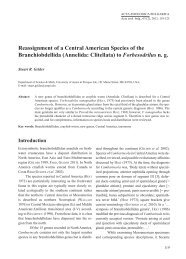
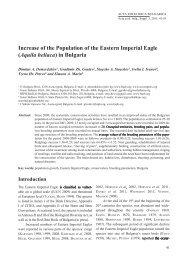
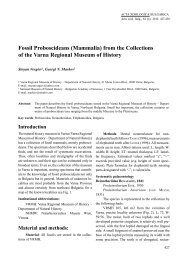
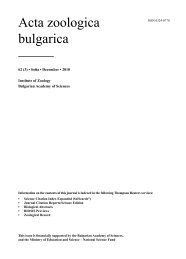
![table of contents [PDF] - Acta zoologica bulgarica](https://img.yumpu.com/52655254/1/186x260/table-of-contents-pdf-acta-zoologica-bulgarica.jpg?quality=85)
![table of contents [PDF] - Acta zoologica bulgarica](https://img.yumpu.com/52655255/1/186x260/table-of-contents-pdf-acta-zoologica-bulgarica.jpg?quality=85)
